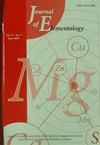泥炭地土壤有机碳动态库与稳定库的关系
IF 0.7
4区 环境科学与生态学
Q4 ENVIRONMENTAL SCIENCES
引用次数: 0
摘要
本文章由计算机程序翻译,如有差异,请以英文原文为准。
Relations between labile and stable pool of soil organic carbon in peatlands
Soil organic carbon (SOC) is a basic element which influences soil processes. In peatlands, carbon is stored in various organic compounds, and any alteration of peatland, especially drain - age, leads to the changes in SOC pools. The aim of the study was to assess the relations be - tween labile carbon and humus fractions, and state of topsoil transformation as well as the relative composition of labile carbon pool in organic soils affected by drainage and rewetting. We extracted labile carbon with hot water (HWC) and stable carbon in the form of humus sub - stances (chemical extraction), and measured the amounts on CN analyser. In the labile pool, we estimated the relative amount of hydrophilic and hydrophobic fractions using chromato - graphic techniques. The state of soil transformation was assessed on the base of water-holding capacity index (W1). Mean HWC concentrations were higher in drained peatlands than in the rewetted one. The chromatographic analysis of labile carbon showed that HWC fraction con - tained more hydrophilic than hydrophobic organic compounds. High concentration of humus fractions in drained peatlands resulted in the higher humification degree, which amounted to 44.8%. The drainage and soil use influenced the quantities of studied labile and stable carbon pools. The HWC concentration proved to be a good indicator of biological changes in organic soils, and may be a good index to monitor the initiation of peat formation at rewetted peatlands which had been previously drained. The state of transformation expressed by W1 index influenced labile carbon pool and relative amounts of hydrophilic part of HWC, as well as free fulvic acids and stable carbon pool (humification degree). The release of labile organic carbon from peatlands implies a loss of sequestered carbon. The stable carbon pool, when subjected to drain - age, becomes vulnerable to microbial changes, and successively becomes secondary humified, therefore the value of humification degree increases.
求助全文
通过发布文献求助,成功后即可免费获取论文全文。
去求助
来源期刊

Journal of Elementology
ENVIRONMENTAL SCIENCES-
CiteScore
1.80
自引率
12.50%
发文量
15
审稿时长
6-12 weeks
期刊介绍:
The Jorunal of Elementology contains original, experimental and review papers pertaining to the transformations of organic and mineral compounds. The research problems encompass organic and mineral compounds discussed from the angle of physiology, biochemistry and genetics; complex analyses and assessment of the conditions underlying biogeochemical cycles, symptoms of deficiencies and excess of chemical elements as well as their antagonistic and synergistic interactions. The papers published in the journal discusses problems from the fields of medical and health sciences, forestry, veterinary medicine, natural sciences and chemical sciences.
 求助内容:
求助内容: 应助结果提醒方式:
应助结果提醒方式:


